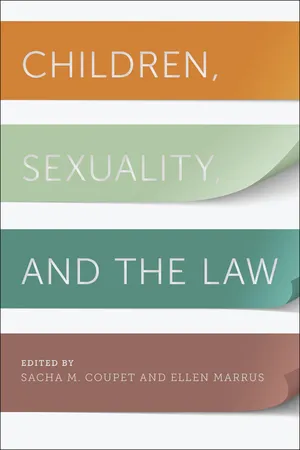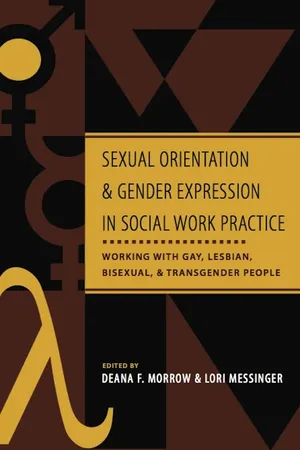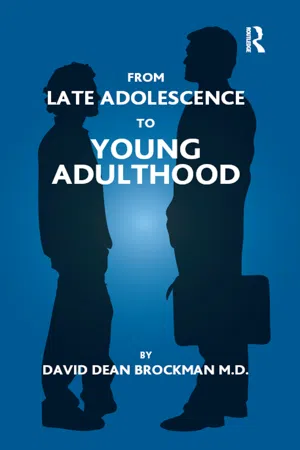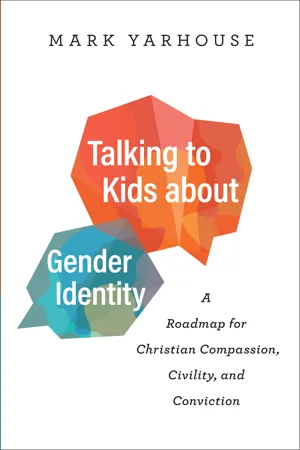Psychology
Gender Identity
Gender identity refers to an individual's internal sense of their own gender, which may or may not align with the sex they were assigned at birth. It is a deeply personal and subjective experience that can encompass a range of identities beyond the traditional binary of male and female. Gender identity is a fundamental aspect of a person's self-concept and can have significant implications for their psychological well-being.
Written by Perlego with AI-assistance
Related key terms
10 Key excerpts on "Gender Identity"
- eBook - ePub
- Sacha M. Coupet, Ellen Marrus(Authors)
- 2015(Publication Date)
- NYU Press(Publisher)
5Gender Identity, in contrast, is a much more complex concept. “Whereas biological sex is determined by genetic and anatomical characteristics, gender is an acquired identity that is learned, changes over time, and varies widely within and across cultures.”6 To borrow again from the analogy above, Gender Identity is the software that enables us to understand ourselves as male or female.7 It has been variously defined as either “knowing that one is a member of one sex rather than the other,” “the degree to which one perceives the self as conforming to cultural stereotypes for one’s gender,” or “a fundamental sense of acceptance of, and belonging to, one’s gender.”8 In 2007, a panel of experts in international human rights law and on sexual orientation and Gender Identity published the following comprehensive definition of Gender Identity: “each person’s deeply felt internal and individual experience of [a gendered self], which may or may not correspond with the sex assigned at birth, including the personal sense of the body (which may involve, if freely chosen, modification of bodily appearance or function by medical, surgical or other means) and other expressions of gender, including dress, speech and mannerisms.”9Gender identities are believed to function on two levels—the individual, in reference to one’s own perceived gender and the collective, in reference to perceiving oneself as a member of a gender group.10 Breaking down this broader concept into a multidimensional model, gender researchers have proposed five major components that capture the underlying cognitive dimensions of Gender Identity: “(a) membership knowledge (knowledge of membership in a gender category); (b) gender typicality (the degree to which one feels one is a typical member of one’s gender category); (c) gender contentedness (the degree to which one is happy with one’s gender assignment); (d) felt pressure for gender conformity (the degree to which one feels pressured from parents, peers, and self for conformity to gender stereotypes); and (e) intergroup bias (the extent to which one believes one’s own sex is superior to the other).”11 - eBook - ePub
Sexual Orientation and Gender Expression in Social Work Practice
Working with Gay, Lesbian, Bisexual, and Transgender People
- Deana Morrow, Lori Messinger(Authors)
- 2006(Publication Date)
- Columbia University Press(Publisher)
GENDER AND THEORIES OF ITS DEVELOPMENTAs intersexed individuals have increasingly come together and shared their common experiences, organizations such as the Intersex Society of North America (1994) seek the adoption of a new medical model. For example, they state that surgery should be avoided unless it is medically necessary. They advocate for qualified mental health care for the child and family and for the empowerment of intersexed people toward understanding their status and their ability to choose or reject medical intervention.Gender typically refers to the subjective, social status of a person as a woman or a man (Devor, 1998). Originally a linguistic term to designate masculine, feminine, or neuter nouns, the term gender was adapted in 1955 by sexologist John Money (1994) in order to better convey the relationship between biological and social influences on male and female identities. Gender is a social construct, and a culture’s social systems are grounded in gender-based concepts (Kessler, 2000). Members of social systems learn gender roles that are consistent with these cultural beliefs, along with the signs and symbols of these roles, such as names and pronouns, appropriate ways to speak, move, and dress, and occupational choices.Gender Identity is the innate sense of being a man, woman, or other gender such as trans. Being internally felt, it is private and invisible. Gender expression is the communication of one’s gender. Only if people choose to disclose their Gender Identity is it possible to know whether it matches their gender expression (Brown & Rounsley, 1996). People are seen as gender-congruent if their Gender Identity, gender role, and all its associated symbols are in agreement (Bullough, 2000) and gender-variant when any of these aspects of self-identity or self-expression seem incongruent with each other or with the person’s sex (Devor, 1998).Although there are numerous theories on the development of Gender Identity in general, very few examine transgender identities. Attempts during the last forty years to identify the biopsychosocial processes that explain how and why transgenderism/transsexualism occurs have yielded inconclusive results (Cole et al., 2000; Michel, Mormont, & Legros, 2001). Gagné and Tewksbury (1998) noted that one limitation of much of the research on trans individuals is that it has come from medical, psychiatric, or deviance perspectives, with limited consideration given to the social contexts in which these people live. Another shortcoming of this research is that most has focused only on MTF individuals (Devor, 1997). - eBook - ePub
- Justin J. Lehmiller(Author)
- 2017(Publication Date)
- Wiley-Blackwell(Publisher)
Although many people use these words interchangeably, it is important to recognize that they have very different meanings and refer to separate aspects of the self. Sex is the term we use to categorize whether someone is biologically male, female, or intersex. There are three different dimensions of sex we will discuss momentarily: chromosomes, gonads, and hormones. In contrast, gender is a psychosocial term that encapsulates all of the psychological, cultural, and social characteristics we think of as belonging to men, women, and other gender groups. Thus, gender refers to our set of expectations about what makes someone masculine or feminine. Related to the concept of gender are three other important terms that will come up repeatedly throughout this chapter and later in the book: Gender Identity, gender roles, and gender stereotypes. Gender Identity refers to an individual's own psychological perception of being male, female, neither, both, or something in between. Although people's Gender Identity is usually consistent with their biological sex, this is not always the case. Thus, someone with a biological sex of male could identify as female and vice versa. This is a form of transgenderism, a concept we will discuss at length later in this chapter. Figure 5.1 Chaz Bono is a female-to-male transsexual who received international media scrutiny upon announcing that he was transitioning into a man. Chaz and others like him are an important reminder than not everyone fits neatly into a two-category gender system. ©s_bukley, 2013. Used under license from Shutterstock.com. Gender roles refer to a set of cultural norms or rules that dictate how people of a specific sex “should” behave - eBook - ePub
- David Dean Brockman(Author)
- 2018(Publication Date)
- Routledge(Publisher)
Chapter 3 Gender and Sexual Identity The terms Gender Identity and sexual identity in the psychoanalytic literature are confusing at best, but the definitions in Money and Ehrhardt’s (1972) classic book Man and Woman Boy and Girl are helpful and elegant in their simplicity. They speak of psychosexual differentiation beginning with the prenatal period of embryonic development and continuing throughout the postnatal period of social and psychological development. They emphasize the theme of a complex interaction of hormones, chromosomes, genes, and environmental influences. Their emphasis on their experience with hermaphrodites and pseudohermaphrodites, and the presence of a suitable penis to guide them in making decisions about sex reassignment, has been seriously questioned by Diamond and Sigmundson’s (1997) long-term review of the case of a boy as well as by an editorial (Reiner, 1997). Gender Identity is defined by Money and Ehrhardt “as the sameness, unity, and persistence of one’s individuality as male or female (or ambivalent) in greater or lesser degree, especially as it is experienced in self awareness of behavior. Gender Identity is the private experience of gender role and gender role is the public expression of Gender Identity” (p. 284). In Zucker and Bradley’s (1995) experience, Gender Identity is taken very seriously by preschoolers in their affective responses to questions if they belong to the opposite sex. Gender disorders in children, usually males, often lead to adolescent and young adult homosexuality. In special cases, psychoanalytic therapeutic intervention can felicitously transform this trajectory from a gay orientation into a solid heterosexual one (Greenson, 1966; Haber, 1991). Most researchers in this area, including Tyson (1998), use a model consisting of Gender Identity, gender role, and sexual orientation - eBook - ePub
Talking to Kids about Gender Identity
A Roadmap for Christian Compassion, Civility, and Conviction
- Yarhouse, Mark(Authors)
- 2023(Publication Date)
- Bethany House Publishers(Publisher)
When we talk about gender, we are generally referring to the cultural, psychological, and social aspects of male or female. Gender Identity refers to a person’s experience of themselves as a particular gender. For most people, this is a biological male’s experience of himself as a boy or man, and a biological female’s experience of herself as a girl or woman.But there are exceptions to these categories. When we consider biological sex, we recognize that some people are born intersex; that is, they have an uncommon medical condition (sometimes referred to as a disorder of sex development) where they share reproductive tissue of both male and female, or may not be able to be readily identified as a boy or a girl at birth.Likewise, when we consider Gender Identity, some people do not experience themselves as the gender that corresponds to their biological sex. A child who is biologically male may not experience himself as a boy; a biological female may not experience herself as a girl.When a person’s Gender Identity does not align with their biological sex and that misalignment is painful or distressing to them, we refer to that distress as gender dysphoria . If the distress is severe enough and the gender discordance is significant enough, they might warrant the diagnosis of Gender Dysphoria. Gender dysphoria resides along a continuum of severity or intensity; some people may not have a formal diagnosis but still experience some gender dysphoria. Gender dysphoria can vary in intensity from person to person; it can also ebb and flow in the same person over time, becoming a more or less intense experience.When we ask, “What causes gender dysphoria?” we’re often really asking, “What causes a person to experience a Gender Identity that does not reflect their biological sex?” I sometimes refer to this experience as gender incongruence or gender discordance - eBook - ePub
- Colette Chiland(Author)
- 2018(Publication Date)
- Routledge(Publisher)
CHAPTER THREE Gender IdentityEvery society draws a distinction between men and women, and sometimes also between other, minority, categories. Each of us has the intimate feeling of being either a man or a woman; some feel themselves to be in an ambiguous situation. That feeling was for long known as one’s “sexual identity”, but nowadays that term is more often used to refer to one’s erotic inclination—homosexual, heterosexual or bisexual. Then the idea of “gender” appeared, followed by that of “Gender Identity”.The advent of gender
In grammar, of course, the concept of gender is by no means recent. Masculine, feminine and neuter dictate the rules of grammatical agreement between different parts of speech.Gender is not a universal grammatical category (Corbett, 1991). To assume that it is is an ethnocentric illusion held by Indo-Europeans, all of whose languages have two or three genders. There are, however, many languages—notably Chinese—which do not have that notion; this does not prevent those who speak a genderless language from drawing a distinction between men and women. Linguistic gender does not create sex.Gender in the sense of one’s psychological or social sex appeared for the first time in John Money’s 1955 paper, where he writes of “gender role”: “The term gender role is used to signify all those things that a person says or does to disclose himself or herself as having the status of boy or man, girl or woman, respectively. It includes, but is not restricted to, sexuality in the sense of eroticism.” (Money, 1955, pp. 254) According to Money (1985), it was Evelyn Hooker who, in an exchange of letters with him, first used the term “Gender Identity”. Then—still according to Money—Robert Stoller advocated the “partitioning” between sex, which is biological, and gender, which is psychological and social, before going on to publish his two-volume Sex and Gender - eBook - ePub
Art, Education and Gender
The Shaping of Female Ambition
- Gill Hopper(Author)
- 2015(Publication Date)
- Palgrave Macmillan(Publisher)
Yet how we align ourselves with our particular gender, or how knowledge of the supposed inherent characteristics of our gender shapes our psychological selves or identities (Knowles and Lander, 2011), is of particular importance, not least with respect to its impact on how we live our lives. For many, socially agreed upon and learned signifiers of male and female (dress codes, legitimated behaviours and expectations) are established from birth within the family; and although interpretations may be broad, such ‘gender signifiers’ will undoubtedly inform the child’s developing identity as a female or male. Additionally, almost all contact with the child – the way the child is related to and the way the person enacts that relationship – will in part be shaped by culturally defined and gendered expectations. Such behaviours seem to be maintained to a lesser or greater degree within the wider political, cultural and economic structures of an ever changing society. Indeed, as Mead argued in her seminal text Male and Female (1949), differences in character and behaviour between societies are often learned and shaped not by genetics but by cultural patterns passed on through the generations – a view that is supported by many today. According to the early, highly influential work of Freud (1923), the psychological self consists of three parts: the id, which desires instant gratification; the ego, or the rational part of the mind that adapts to the reality of the social context and the needs of others – also coined ‘the reality principle’(Rennison, 2001); and the superego, or ‘the internalised voice of parents, carers and society which provide the individual with the rules and regulations that guide it when it moves beyond primary narcissism’ (Rennison, 2001: 39 in Knowles and Lander, 2011). All three parts are subject to change. Yet, according to Lawler (2009), in developing, achieving and maintaining our identity, genetic heritage and DNA coding also have a part to play - eBook - ePub
Conducting Research in Developmental Psychology
A Topical Guide for Research Methods Utilized Across the Lifespan
- Nancy Jones, Melannie Platt, Krystal D. Mize, Jillian Hardin, Nancy Jones, Melannie Platt, Krystal D. Mize, Jillian Hardin(Authors)
- 2019(Publication Date)
- Routledge(Publisher)
12 Gender Identity Development Madhavi Menon and Sara M. Gorman Introduction to the Topic Beginning in early childhood, children become aware of their membership in a gender category; at around the same time they also appear to know that persons of each category behave differently from each other. How this knowledge affects their personalities, self-concepts, and social behaviors has been a topic of interest for developmental researchers (Perry, Pauletti, & Cooper, 2019; Zosuls, Andrews, Martin, England, & Field, 2016 etc.). Gender is all-pervasive, and many people tend to view the world along binary lines divided by gender. In fact, gender is oftentimes the first bit of information that parents-to-be receive about their unborn child. Many would-be parents have been known to throw elaborate “gender-reveal” parties where they learn about the sex of their unborn child, often in the presence of friends and well-wishers. “Is it a girl or a boy ?” is a question everyone wants answered! The ramifications of such gender labels are fairly quick; parents might paint the nursery in blue or pink. Friends and family might buy clothes and toys based on the gender label, and may even ascribe gender stereotypic adjectives to the baby’s behavior both in-utero and outside (including calling their infant son “big guy” while calling their infant daughter “sweetie”). Thus, even before a child is born, people around the child view gender as an important attribute that often determines how they might respond to the child. And so begins the child’s internalization of gendered norms and standards and the eventual development of their Gender Identity. Developmental psychologists have been particularly interested in how this gender knowledge affects individual personalities, self-concepts, and social behavior - eBook - ePub
Autobiographical Memory and the Construction of A Narrative Self
Developmental and Cultural Perspectives
- Robyn Fivush, Catherine A. Haden, Robyn Fivush, Catherine A. Haden(Authors)
- 2003(Publication Date)
- Psychology Press(Publisher)
In this chapter, we explore one critical aspect of identity, namely gender. Whereas many theorists have conceptualized gender as a foundational construct, setting the stage for an understanding of self (e.g., Chodorow, 1978; Gilligan, 1982), we argue instead that gender and identity are defined dialectically in the process of interacting with others (e.g., Deaux & Major, 1987). Most important, from a developmental perspective, we argue that both gender and identity must be viewed as evolving concepts that change as a function of the specific developmental tasks individuals face as well as the specific contexts in which particular aspects of gender and identity are privileged over others; there are some developmental and situational contexts in which gender will be foregrounded and differences between females and males maximized, whereas there are other developmental and situational contexts in which gender will be backgrounded, leading to few differences between females and males. From this perspective, gender cannot be conceptualized in terms of the ways in which females and males are different, but rather must be contextual-ized in terms of situations in which aspects of male and female identity are more or less likely to be highlighted.We first present evidence for this assertion and then try to provide a developmental contextual model for understanding when and why gender may or may not be a critical aspect of identity.GENDER, IDENTITY, AND AUTOBIOGRAPHY
Scattered throughout the literature on autobiographical memory, a number of studies demonstrate differences in male and female life stories (see Buck-ner, 2000, and Fivush & Buckner, 2000, for reviews). Stemming from postmodern and feminist theories of Gender Identity, researchers have focused on explanations of these differences as emanating from the ways in which females and males characterize their relationships to and with others in recounting their past experiences (e.g.,Cross & Madson, 1997; Gergen, 1992). Females are hypothesized to be relationally oriented and thus perceive themselves as being situated in a rich web of interconnections with others, and portray themselves as socially and emotionally entwined with those around them. Males, in contrast, are thought to be more autonomous in their orientation, presenting themselves as independent of others, focusing on individual goals and achievements. These differences are often assumed to be rooted in basic developmental experiences (Chodorow, 1978; Gilligan, 1982). According to Chodorow (1978), our first intimate interactions are with our mothers and our identities depend on how we negotiate that relationship. Males must break away from the mother in order to establish a masculine identity; thus they come to view themselves as unconnected, autonomous beings. Females, on the other hand, remain identified with the mother, and thus their identity is based on maintaining connections. This difference is expressed as ways of being in the world, with males continuously carving out a separate space for themselves, apart from others, and females creating interpersonal networks, connected with others. - eBook - ePub
The Psychology of Human Social Development
From Infancy to Adolescence
- Sandie Taylor, Lance Workman(Authors)
- 2018(Publication Date)
- Routledge(Publisher)
Plate 8.4 A girl’s and boy’s stereotype of what it is to be mum and dad. (Shutterstock 195221240.)Gender is one example of a social category that we become aware of early on in our development. Gender is a culturally defined social category used to distinguish between femininity and masculinity. This is not to be confused with biologically driven sex divisions of female and male. Individuals are born female or male (with the exception of hermaphrodites who are born with ambiguous genitalia) but become feminine or masculine through complex developmental processes occurring early on in the lifespan. In Chapter 6 we considered how a Gender Identity develops and the theoretical approaches accounting for how this occurs (see Box 6.5 ). In this chapter the intention is to consider the other aspects of gender-concept formation that influence social behaviour. One such area is the development of gender typing. Gender typing can only occur once a child has figured out that she is a girl or he is a boy. Once this has been established the child is likely to be receptive to further socialisation processes. Gender role models portraying socially acceptable feminine and masculine behaviours provide children with gender-based beliefs. These gender-based beliefs are based on gender stereotypes . Gender stereotypes are widely held beliefs about female and male traits. One way of examining gender stereotypes is to present individuals with adjectives commonly associated with males and females who then categorise them accordingly. Williams and Bennett (1975) studied this by asking a large group of individuals to categorise adjectives as either female or male. They found that 90 per cent of the adjectives were categorised as typically female or male. There was strong agreement across participants suggesting a robust effect of socialisation. Ruble (1983) repeated this exercise and found adjectives of ability, personality and social behaviour typically describing female and male stereotypes (see Box 8.4
Index pages curate the most relevant extracts from our library of academic textbooks. They’ve been created using an in-house natural language model (NLM), each adding context and meaning to key research topics.









